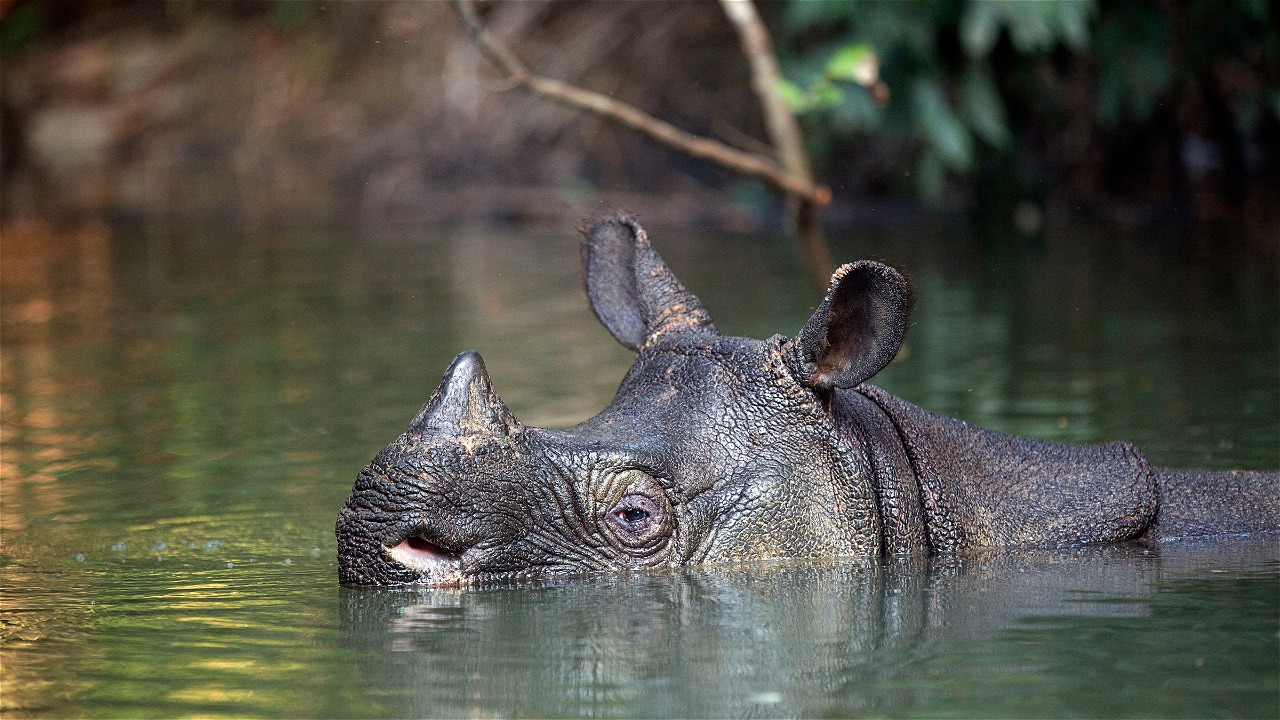VISITING "RHINO HOUSE", HSBC VOLUNTEERS SHOW THEIR CONCERN FOR RHINO CONSERVATION
By: Natalia Trita Agnika
That morning, Saturday (23/09), the day after the commemoration ceremony of World Rhino Day 2017, the Cilintang area in Ujung Kulon National Park (TNUK) was again enlivened by the presence of elementary school children. Around 200 students from SD Ujung Jaya 1 and SD Ujung Jaya 2 enthusiastically participated in conservation education activities organized by WWF-Indonesia's Panda Mobile.
A total of 16 volunteers consisting of employees of PT Bank HSBC Indonesia also accompanied the Panda Mobile team in providing conservation education to the students. When drh. Gita Alvernita Andre, a veterinarian from WWF-Indonesia Ujung Kulon Program, gave an explanation about rhinos, the HSBC volunteers also listened seriously. "In Indonesia, there are two species of rhinos, namely the Javan Rhino and the Sumatran Rhino. The basic difference between the two rhinos is seen in their horns. The male Javan Rhino has one horn, while the Sumatran Rhino has two. In addition, Javanese rhinos are hairless, while Sumatran rhinos have hair," explained drh. Gita.
Antonius Noviadi, one of the volunteers HSBC asked a question about the current population of Javan Rhinos. "The 67 individuals released yesterday is the number of all Javan Rhinos in Indonesia, including in zoos?" he asked. Answering the question, drh. Gita explained that currently, Javan Rhinos are only found in their natural habitat, Ujung Kulon, and none in captivity. Therefore, the way to observe Javan Rhinos is by installing camera traps on trees in the forest. The monitoring teams will take recordings periodically and replace the camera batteries.
Meanwhile, at the same time, a group of 12HSBC volunteers cycled from Villa Honje to Cilintang. The hot, dusty air and rocky road did not dampen the enthusiasm of the cyclists towards the "original home" of the Javan Rhino. After traveling for about two hours, they arrived at the activity area and joined other volunteers who had finished doing conservation education activities with Panda Mobile to plant rhino food trees in the TNUK area. What the HSBC and WWF-Indonesia Ujung Kulon Program are doing is one way of enriching rhino food to improve the quality of Javan Rhino habitat in Ujung Kulon.
The day's activities were closed with a brief discussion on Javan Rhino conservation efforts with resource person drh. Kurnia Oktavia Khairani, Project Leader Ujung Kulon. In her explanation, Kurnia told about the history of WWF's existence in Indonesia which was marked by the Javan Rhino conservation program in Ujung Kulon and the development of rhino conditions in Indonesia. "The theme of this year's World Rhino Day in Indonesia is 'Darurat Rhino Indonesia' because the condition of the two types of rhinos in Indonesia is currently in an emergency and requires public assistance to contribute to conservation programs, one of which is like this HSBC which is quite consistent in providing support for programs at WWF Ujung Kulon," he explained. Kurnia also added that in the journey to save the Javan Rhino, WWF Ujung Kulon realizes that to save the rhino means also having to think about the people who live in the buffer villages around TNUK.
Besides focusing on rhino conservation through monitoring and habitat management, WWF also conducts community-based programs. So far, HSBC has played a role in the Revive the Reef program (coral reef planting that involves the community so that it can become an alternative livelihood through eco-tourism). This year, HSBC also supports the sustainable tourism program. The hope is that when communities have alternative livelihoods, they will reduce their dependence on the national park and protect the habitat of Javan Rhinos.
The next day, Sunday (24/09), some ofHSBC's volunteers saw firsthand the Revive the Reef program in the Badul Island area accompanied by the Paniis Lestari Group. This group is one of the ecotourism groups assisted by WWF-Indonesia Ujung Kulon Program. Meanwhile, some of the other participants tried their hand at carving and batiking a rhino statue out of wood. Guided by Mardi from the Ciwisata (Cinibung Wisata) group, the HSBC volunteers followed the steps. "Initially, there was no typical Ujung Kulon souvenir, then WWF provided training to make a typical souvenir in the form of a miniature Javan Rhino," said Mardi. In addition to being an alternative livelihood, the rhino carving is one of the Ciwisata Group's ways to introduce and preserve the Javan Rhinos that live in Ujung Kulon National Park, Banten.





